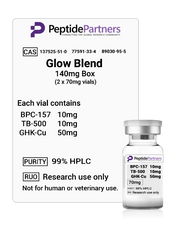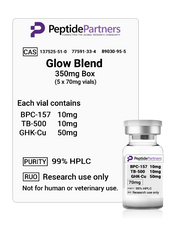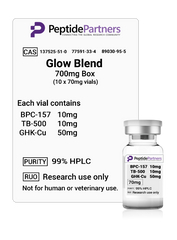Your Cart

For Research Use Only. Not for Use in diagnostic procedures.
This product is solely intended for research purposes as a chemical compound. Its designation permits its use exclusively for in vitro testing and laboratory experimentation. All information regarding this product provided on our website is purely educational. By law, any form of bodily introduction of this product into humans or animals is strictly prohibited. It should only be handled by professionals who are licensed and qualified. This product is neither a drug, food, nor cosmetic, and must not be misrepresented, misused, or mislabeled as such.






Glow Blend: BPC-157/TB-500/GHK-Cu
Price:
- $224.00
- $700.00
Glow Blend:
- BPC-157 10mg
- TB-500 10mg
- GHK-Cu 50mg
Save over 65%!
Swipe right to view full table →
 |
Peptide Sciences | Liberty Peptides | |
Cost per milligram |
$1.20 - 1.60 |
$5.25 | $2.00 |
Purity |
99.52% |
99.6% | UNK |
Certified Endotoxin-safe |
Yes |
No | No |
Independently Tested |
Yes |
No | No |
Peptide Partners Manufacturer Id: DF05
Batch Id: GB20251012
Overview
(For educational purposes only)
The "GLOW" peptide stack is a combination therapy protocol—usually administered as an injectable blend—comprising BPC-157, TB-500, and GHK-Cu. This powerful trio is designed to synergistically accelerate tissue healing, reduce inflammation, and rejuvenate the skin and connective tissue, making it popular in regenerative, sports, and aesthetic medicine contexts.[1][2][3][4][5]
Component Overview & Mechanisms
BPC-157 (Body Protection Compound)
-
A synthetic peptide derived from a gastric protein, BPC-157 has been shown to promote soft tissue regeneration, robust angiogenesis (blood vessel formation), decrease inflammation, and aid in healing muscle, tendon, gut, and nerve injuries.[2][1]
-
It accelerates tissue repair by boosting fibroblast migration and collagen synthesis and is known for its potential to support gastrointestinal and musculoskeletal recovery.[4]
TB-500 (Thymosin Beta-4 Fragment)
-
TB-500 is a synthetic segment of the naturally occurring protein thymosin beta-4, which modulates actin, promotes cellular migration, and speeds wound healing throughout the body.[1][2]
-
It supports systemic tissue repair, reduces fibrosis, improves flexibility and mobility, and reduces local and systemic inflammation in connective tissue and muscle.[3]
GHK-Cu (Copper Tripeptide-1)
-
GHK-Cu is a naturally occurring peptide with a high affinity for copper, well-documented for stimulating collagen and elastin production in the dermis.[2][1]
-
It helps with wound healing, skin firmness and elasticity, hair regrowth, DNA repair, and has anti-inflammatory and antioxidant properties, making it a go-to for anti-aging and dermal rejuvenation.[5][3][4]
Benefits of the GLOW Stack
-
Accelerated Healing: GLOW is used to speed recovery from sports injuries, surgery, or trauma, targeting regeneration in tendons, ligaments, muscle, and skin.[3][1][2]
-
Anti-Inflammatory: All three peptides exhibit strong anti-inflammatory properties, which helps reduce pain, swelling, and tissue irritation post-injury.[1][3]
-
Skin Rejuvenation: GHK-Cu specifically boosts collagen production for significant improvements in skin tone, texture, firmness, and elasticity, with a reduction in visible aging.[4][5][1]
-
Joint & Fascia Support: TB-500 supports joint health and soft tissue flexibility; combined with BPC-157, it can lessen fibrosis and support connective tissue resilience.[3][4]
-
Gut Healing: BPC-157 offers gastrointestinal protection and is indicated (experientially) for conditions like leaky gut or IBD in adjunctive settings.[1]
-
Enhanced Collagen Synthesis: Both BPC-157 and GHK-Cu stimulate new collagen and elastin, strengthening tissues, reversing damage, and fortifying recovery.[5][1]
-
Aesthetic Enhancement: The blend is marketed widely for “radiance,” reducing scarring, improving skin luminosity, and assisting in post-procedural and aesthetic healing protocols.[6][4][3]
Typical Administration
-
Regimen: Often prepared as a single daily injection, with a monthly protocol (30 days common) for maximal effect.[4][3]
-
Dosing (research/clinic ranges): BPC-157 (5mg), TB-500 (10mg), GHK-Cu (10–27mg) per vial/dose.[7][2][1]
-
Target Users: Those seeking rapid recovery from soft tissue injuries, optimized post-surgical rehabilitation, skin rejuvenation/cosmetic enhancement, and enhanced healing capacity.[2][3][1]
Clinical Considerations
-
While individual support from each peptide is well characterized in wound healing, regeneration, and aesthetic medicine, limited large-scale clinical trials exist for the exact GLOW combination.
-
Most data are based on in vitro, animal, and limited human experience, and compounded formulas are intended for research or physician-guided use; they are not FDA-approved for disease treatment.[5][2][3][1]
-
Users should be aware of purity standards, storage requirements (refrigerate after reconstitution), and possible adverse reactions (rare and usually local in nature).[2][3]
In summary
The GLOW peptide blend leverages the complementary biology of BPC-157, TB-500, and GHK-Cu to support rapid tissue healing, minimize inflammation, and deliver visible skin rejuvenation. Its use is increasing in sports recovery, post-surgical support, and cosmetic medicine as a regenerative protocol for those seeking “glow” from the inside and out.[3][4][5][1][2]
⁂
-
https://revolutionhealth.org/blogs/news/glow-peptide-bpc157-tb500-ghkcu
-
https://ocweightlossandmedspa.com/peptide-therapy/glow-blend-peptide/
-
https://jaycampbell.com/fat-loss/glow-peptide-protocol-bpc-157-tb-500-ghk-cu/
-
https://fountainofyouthswfl.com/peptide-programs/glow-peptide-protocol/
-
https://alphabiomedlabs.com/products/glow-ghk-cu-27mg-bpc-157-5mg-tb500-10mg
-
https://www.toxxology.com/post/unlocking-the-power-of-peptides
-
https://www.hubmeded.com/blog/glow-peptide-injection-a-revolutionary-approach-to-skin-rejuvenation
-
https://www.injectiongal.com/blog/benefits-of-peptides-for-skin
-
https://happyhormonesmd.com/wp-content/uploads/2024/12/BPC-157-Patient-Information.docx.pdf
-
https://www.reddit.com/r/MTHFR/comments/1incb3y/glow_ghkcu_bpc1257_tb500_peptide_and_mthfr/
-
https://www.peptidesciences.com/bpc-157-tb-500-ghk-cu-30mg-glow-blend
-
https://paramountpeptides.com/products/glow-ghk-cu-27mg-bpc-157-5mg-tb500-10mg
Storage Instructions:
All of our manufacturing partners produce peptides using the Lyophilization (Freeze Drying) process, ensuring products maintain stability for shipping and storage for 6+ months.
Once peptides have been received, it is imperative that they are kept cold and away from light. If the peptides will be used immediately, or in the next several days, weeks or months, short-term refrigeration under 4°C (39°F) is generally acceptable. Lyophilized peptides are usually stable at room temperatures for several weeks or more, so if they will be utilized within weeks or months such storage is typically adequate.
However, for longer-term storage (several months to years) it is more preferable to store peptides in a freezer at -80°C (-112°F). When storing peptides for months or even years, freezing is optimal in order to preserve the peptide's stability.
Third-party testing
Peptide Partners is committed to providing high-purity peptides at wholesale prices by frequently auditing its manufacturing partners using third-party laboratories. Independent analysis is vital to ensuring the quality and authenticity of your research peptides. Never trust a supplier that doesn't submit to third-party testing. Never trust a certification that cannot be independently verified. All of the certificates that we provide can be validated on the third-party laboratory's website.
Each product description contains a Manufacturer ID corresponding to the producer of that product. The table below contains the most recent third-party analyses for all manufacturers and peptides listed on Peptide Partners.
Current Purity certifications
Swipe right to view full table →
| Peptide | Batch Id | Manufacturer | Date | Purity | Laboratory | |
| GLP-RT | RP20251001 | DF05 | 2025-10-13 | 99.86 | TrustPointe | View File |
| GLP-TRZ | TZ20250915 | DF05 | 2025-10-03 | 99.74% | TrustPointe | View File |
| Retatrutide | RP20250929 | VI32 | 2025-10-03 | 99.47% | TrustPointe | View File |
| Humanin | HP20250805 | WF03 | 2025-09-19 | 99.92% | BioRegen | View File |
| MOTS-c | YC20250807 | WF03 | 2025-09-19 | 99.87% | BioRegen | View File |
| DSIP | DS20250820 | SH07 | 2025-09-19 | 99.88% | BioRegen | View File |
| SS-31 | SY20250806 | WF03 | 2025-09-19 | 99.70% | BioRegen | View File |
| CJC/Ipamorelin | CI20250805 | WF03 | 2025-09-11 | 99.84% | TrustPointe | View File |
| BPC-157 | BP20250808 | WF03 | 2025-09-05 | 99.99% | TrustPointe | View File |
| Sermorelin | SM20250723 | WF03 | 2025-08-27 | 99.84% | BioRegen | View File |
| Tesamorelin | TS20250722 | WF03 | 2025-08-22 | 99.10% | TrustPointe | View File |
| CJC-1295 ND | CJ20250724 | WF03 | 2025-08-20 | 99.43% | TrustPointe | View File |
| Semaglutide | SM20250801 | EJ12 | 2025-08-20 | 99.34% | TrustPointe | View File |
| Ipamorelin | IP20250721 | WF03 | 2025-08-15 | 99.64% | TrustPointe | View File |
| GHK-Cu | CU20250717 | SH07 | 2025-08-09 | 99.73% | BioRegen | View File |
| Tirzepatide | TZ20250730 | EJ12 | 2025-08-08 | 99.41% | TrustPointe | View File |
| NAD+ | ND20250503 | SH07 | 2025-07-31 | 99.76% | BioRegen | View File |
| VIP | VP20250511 | SH07 | 2025-07-31 | 99.42% | BioRegen | View File |
| Retatrutide | CD20250708 | SH07 | 2025-07-25 | 99.42% | TrustPointe | View File |
| BPC/TB500 | BB20250630 | SH07 | 2025-07-17 | 99.52% | TrustPointe | View File |
| TB500 (TB4) | TB20250614 | SH07 | 2025-07-17 | 99.68% | TrustPointe | View File |
Current Endotoxin Certifications
Swipe right to view full table →
| Peptide | Batch Id | Manufacturer | Date | USP<85> Conformation | Laboratory | |
| Retatrutide | RP20251001 | DF05 | 2025-10-13 | Conforms | TrustPointe | View File |
| Tirzepatide | TZ20250915 | DF05 | 2025-10-03 | Conforms | TrustPointe | View File |
| Retatrutide | RP20250929 | VI32 | 2025-10-03 | Conforms | TrustPointe | View File |
| Humanin | HP20250805 | WF03 | 2025-09-19 | Conforms | BioRegen | View File |
| MOTS-c | YC20250807 | WF03 | 2025-09-19 | Conforms | BioRegen | View File |
| DSIP | DS20250820 | SH07 | 2025-09-19 | Conforms | BioRegen | View File |
| SS-31 | SY20250806 | WF03 | 2025-09-19 | Conforms | BioRegen | View File |
| CJC/Ipamorelin | CI20250805 | WF03 | 2025-09-03 | Conforms | TrustPointe | View File |
| BPC-157 | BP20250808 | WF03 | 2025-09-03 | Conforms | TrustPointe | View File |
| Bacteriostatic Water | BAC20250807 | SH07 | 2025-08-27 | Conforms | BioRegen | View File |
| Tesamorelin | TS20250722 | WF03 | 2025-08-20 | Conforms | TrustPointe | View File |
| CJC-1295 ND | CJ20250724 | WF03 | 2025-08-20 | Conforms | TrustPointe | View File |
| Sermorelin | SM20250723 | WF03 | 2025-08-20 | Conforms | TrustPointe | View File |
| Semaglutide | SM20250801 | EJ12 | 2025-08-20 | Conforms | TrustPointe | View File |
| Ipamorelin | IP20250721 | WF03 | 2025-08-11 | Conforms | TrustPointe | View File |
| GHK-Cu | CU20250717 | SH07 | 2025-08-08 | Conforms | TrustPointe | View File |
| Tirzepatide | TZ20250730 | EJ12 | 2025-08-04 | Conforms | TrustPointe | View File |
| NAD+ | ND20250503 | SH07 | 2025-07-29 | Conforms | TrustPointe | View File |
| VIP | VP20250511 | SH07 | 2025-07-29 | Conforms | TrustPointe | View File |
| Retatrutide | CD20250708 | SH07 | 2025-07-24 | Conforms | TrustPointe | View File |
| BPC/TB500 | BB20250630 | SH07 | 2025-07-17 | Conforms | TrustPointe | View File |
| TB500 (TB4) | TB20250614 | SH07 | 2025-07-17 | Conforms | TrustPointe | View File |
Current Sterility Certifications
Swipe right to view full table →
| Product | Batch Id | Manufacturer | Date | USP<71> Pass/Fail | Laboratory | |
| Bacteriostatic Water | BAC20250807 | SH07 | 2025-09-09 | Pass | TrustPointe | View File |
| Meta-Z | MZR20250713 | DF05 | 2025-08-26 | Pass | TrustPointe | View File |
Verifiable certificates
When obtaining research peptides, it is essential to validate the authenticity of the Certificate of Analysis (COA). Certificate fraud runs rampant throughout the research peptide supply community. The two most common forms are doctored images and stolen certificates. You can check for these two by making sure the third-party laboratory's website shows that the certificate belongs to the supplier and the values haven't been doctored. TrustPointe Analytics provides a few simple rules for verification:
When reviewing a COA, the first thing that should be done is to look for a way to verify that the COA is legitimate – either a link, key, or QR Code. That should take you to the laboratory’s website, not a third party website. If you follow the link and it does not take you to the laboratory’s website (URL), it is likely falsified. Finally, verify that the information on the COA provided matches the COA on the laboratory’s website. People who falsify COAs cannot access the laboratory’s website, so they are unable to alter the original COA.
Beware of fraudulent laboratories
Not only must one remain vigilant about potentially fraudulent certificates, one must also be aware that there are third-party laboratories whose results cannot be considered reliable or scientifically valid. Unfortunately, there is significant evidence to suggest that one of the most popular third-party testing labs does not use scientifically sound methodologies and, in some cases, has fabricated results. There isn't an easy remedy for this problem, but when labs are particularly bad, there tend to be a lot of discussion threads on various social platforms.
Interpreting Endotoxin Results (via TrustPointe)
Our friends at TrustPointe have provided the following detailed explanation to help interpret the results of the endotoxin testing.
We use the Charles River Endosafe PTS system to test for bacterial endotoxins following USP <85> guidelines:
- USP <85> Bacterial Endotoxin Result: <x.xx EU/mL
Because it’s reported as “<x.xx” this indicates the test did not detect endotoxin above the detection limit of the cartridge.- If a result is above the limit of detection of the cartridge, it will be reported as a number (without the "<").
The following are suitability parameters that verify the system was working properly and the sample prep dilution is appropriate for accurate results. Peptides often interfere with endotoxin detection due to their tendency to bind or mask endotoxins, which can lead to inaccurate low results. To overcome this, samples are typically tested at a large dilution to reduce matrix interference and ensure reliable recovery and detection in compliance with USP <85>. If the dilution is not correct, the run will fail suitability and we'll need to adjust the dilution to ensure accurate results. We provide the suitability data to customers for transparency and so they can be confident in the results.
USP <85> Sample CV %:
- CV stands for coefficient of variation, a measure of repeatability.
- For our lab, CV has to be <25% or the result to be considered valid
USP <85> Spike CV %:
- This refers to the precision of the positive control (spiked sample).
- Again, for our lab CV has to be <25% or the result to be considered valid
USP <85> Spike Recovery
- This tells us how much of the known endotoxin spike was recovered from your sample.
- The acceptable range is 50–200% per USP <85>

NOT SUITABLE FOR HUMAN CONSUMPTION – INTENDED FOR RESEARCH ONLY
Thank you for choosing Peptide Partners.
NOTICE: All information provided above is strictly intended for educational and informational purposes. Our products are designed for research use solely and are not approved for human consumption. Please refrain from any form of ingestion.
By making a purchase from Peptide Partners, you acknowledge that you are acquiring Research Chemicals. Our products are exclusively intended for laboratory research purposes.
It is imperative that only qualified and licensed professionals handle this product. Under no circumstances should it be utilized as a drug, agricultural or pesticide product, food additive, or household chemical. Misrepresentation of this product for such purposes is strictly prohibited by law. All content on our website is provided for educational use exclusively. Any form of introduction into the human or animal body is illegal.